小学英语语法点分布-总结(自编)
- 格式:docx
- 大小:23.75 KB
- 文档页数:11
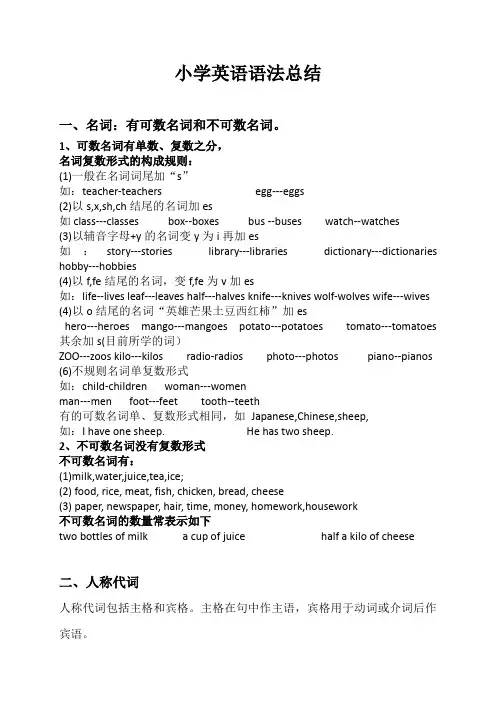
小学英语语法总结一、名词:有可数名词和不可数名词。
1、可数名词有单数、复数之分,名词复数形式的构成规则:(1)一般在名词词尾加“s”如:teacher-teachers egg---eggs(2)以s,x,sh,ch结尾的名词加es如class---classes box--boxes bus --buses watch--watches(3)以辅音字母+y的名词变y为i再加es如:story---stories library---libraries dictionary---dictionaries hobby---hobbies(4)以f,fe结尾的名词,变f,fe为v加es如:life--lives leaf---leaves half---halves knife---knives wolf-wolves wife---wives (4)以o结尾的名词“英雄芒果土豆西红柿”加eshero---heroes mango---mangoes potato---potatoes tomato---tomatoes 其余加s(目前所学的词)ZOO---zoos kilo---kilos radio-radios photo---photos piano--pianos (6)不规则名词单复数形式如:child-children woman---womenman---men foot---feet tooth--teeth有的可数名词单、复数形式相同,如Japanese,Chinese,sheep,如:I have one sheep. He has two sheep.2、不可数名词没有复数形式不可数名词有:(1)milk,water,juice,tea,ice;(2) food, rice, meat, fish, chicken, bread, cheese(3) paper, newspaper, hair, time, money, homework,housework不可数名词的数量常表示如下two bottles of milk a cup of juice half a kilo of cheese二、人称代词人称代词包括主格和宾格。
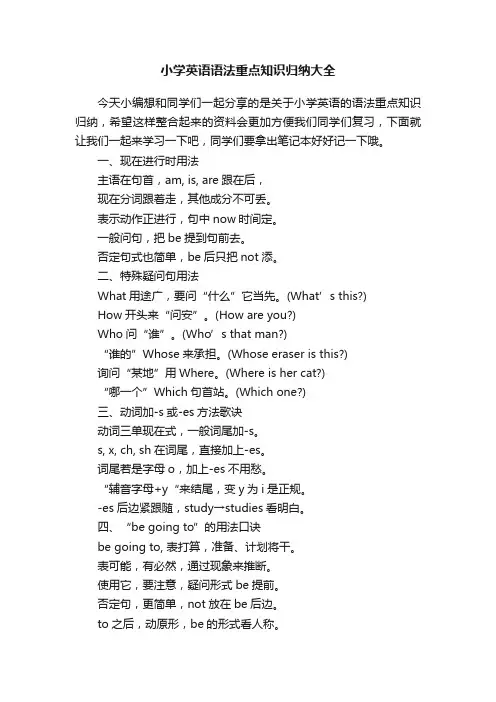
小学英语语法重点知识归纳大全今天小编想和同学们一起分享的是关于小学英语的语法重点知识归纳,希望这样整合起来的资料会更加方便我们同学们复习,下面就让我们一起来学习一下吧,同学们要拿出笔记本好好记一下哦。
一、现在进行时用法主语在句首,am, is, are跟在后,现在分词跟着走,其他成分不可丢。
表示动作正进行,句中now时间定。
一般问句,把be提到句前去。
否定句式也简单,be后只把not添。
二、特殊疑问句用法What用途广,要问“什么”它当先。
(What’s this?)How开头来“问安”。
(How are you?)Who问“谁”。
(Who’s that man?)“谁的”Whose来承担。
(Whose eraser is this?)询问“某地”用Where。
(Where is her cat?)“哪一个”Which句首站。
(Which one?)三、动词加-s或-es方法歌诀动词三单现在式,一般词尾加-s。
s, x, ch, sh在词尾,直接加上-es。
词尾若是字母o,加上-es不用愁。
“辅音字母+y“来结尾,变y为i是正规。
-es后边紧跟随,study→studies看明白。
四、“be going to”的用法口诀be going to, 表打算,准备、计划将干。
表可能,有必然,通过现象来推断。
使用它,要注意,疑问形式be提前。
否定句,更简单,not放在be后边。
to之后,动原形,be的形式看人称。
下列词,要注意,come go和离去(leave)进行时,表将来,牢牢记住莫忘记。
小学英语知识重点一、形容词性物主代词1、形容词性物主代词8个:My your his her its our your their我的你的他的她的它的我们的你们的他(她、它)们的2、形容词性物主代词的特点:1)译成汉语都有"的" eg:my 我的 their 他们的2)后面加名词:eg:my backpack his name3)前后不用冠词 a an theThis is a my eraser(错误)That is your a pen(错误)It's his the pen(错误)3、I(物主代词)my you(物主代词)your he (物主代词)her we (物主代词) our注:在变物主代词时,把原题所给的词加上的,再译成单词就可以了。
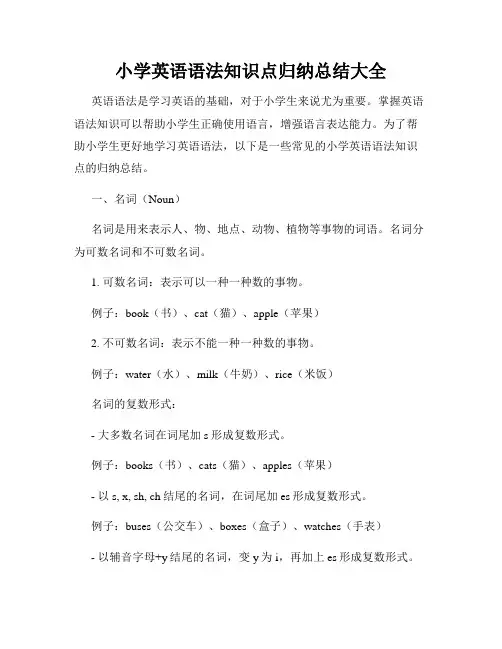
小学英语语法知识点归纳总结大全英语语法是学习英语的基础,对于小学生来说尤为重要。
掌握英语语法知识可以帮助小学生正确使用语言,增强语言表达能力。
为了帮助小学生更好地学习英语语法,以下是一些常见的小学英语语法知识点的归纳总结。
一、名词(Noun)名词是用来表示人、物、地点、动物、植物等事物的词语。
名词分为可数名词和不可数名词。
1. 可数名词:表示可以一种一种数的事物。
例子:book(书)、cat(猫)、apple(苹果)2. 不可数名词:表示不能一种一种数的事物。
例子:water(水)、milk(牛奶)、rice(米饭)名词的复数形式:- 大多数名词在词尾加s形成复数形式。
例子:books(书)、cats(猫)、apples(苹果)- 以s, x, sh, ch结尾的名词,在词尾加es形成复数形式。
例子:buses(公交车)、boxes(盒子)、watches(手表)- 以辅音字母+y结尾的名词,变y为i,再加上es形成复数形式。
例子:babies(婴儿)、flies(苍蝇)、berries(浆果)二、代词(Pronoun)代词是用来代替名词的词语。
代词可以分为主格代词、宾格代词和物主代词。
1. 主格代词:在句子中担任主语的代词。
例子:I(我)、you(你)、he(他)2. 宾格代词:在句子中担任宾语的代词。
例子:me(我)、you(你)、him(他)3. 物主代词:表示所属关系的代词。
例子:my(我的)、your(你的)、his(他的)三、动词(Verb)动词是表示动作、状态或存在的词语。
动词分为及物动词和不及物动词。
1. 及物动词:需要接宾语来完成意义的动词。
例子:eat(吃)、drink(喝)、watch(观看)2. 不及物动词:不需要接宾语就能完成意义的动词。
例子:run(跑)、sleep(睡觉)、sit(坐)动词的时态:- 一般现在时:表示经常性或习惯性的动作。
例子:I eat breakfast every morning.(我每天早上吃早餐。
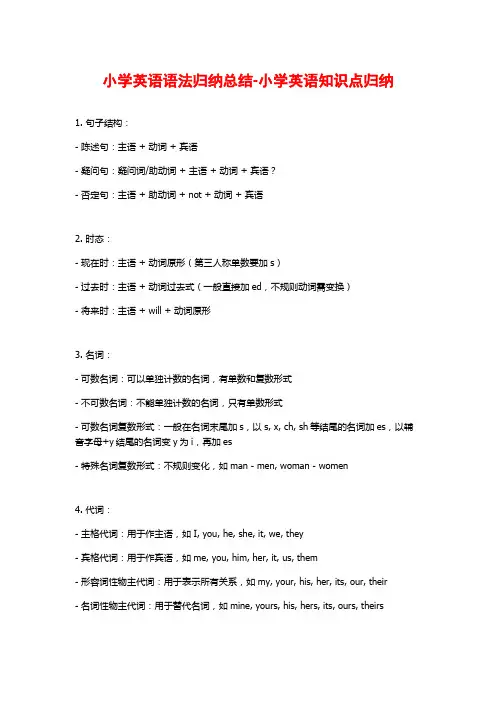
小学英语语法归纳总结-小学英语知识点归纳1. 句子结构:- 陈述句:主语 + 动词 + 宾语- 疑问句:疑问词/助动词 + 主语 + 动词 + 宾语?- 否定句:主语 + 助动词 + not + 动词 + 宾语2. 时态:- 现在时:主语 + 动词原形(第三人称单数要加s)- 过去时:主语 + 动词过去式(一般直接加ed,不规则动词需变换)- 将来时:主语 + will + 动词原形3. 名词:- 可数名词:可以单独计数的名词,有单数和复数形式- 不可数名词:不能单独计数的名词,只有单数形式- 可数名词复数形式:一般在名词末尾加s,以s, x, ch, sh等结尾的名词加es,以辅音字母+y结尾的名词变y为i,再加es- 特殊名词复数形式:不规则变化,如man - men, woman - women4. 代词:- 主格代词:用于作主语,如I, you, he, she, it, we, they- 宾格代词:用于作宾语,如me, you, him, her, it, us, them- 形容词性物主代词:用于表示所有关系,如my, your, his, her, its, our, their- 名词性物主代词:用于替代名词,如mine, yours, his, hers, its, ours, theirs5. 动词:- 基本动词:表示基本动作或状态的词汇,如play, run, eat- 助动词:用来辅助构成时态、人称、语态等形式,如be, do, have- 行为动词与非行为动词:行为动词表示具体的行动,如swim, dance,非行为动词表示状态或感觉,如like, love6. 形容词和副词:- 形容词:描述名词的词,用于修饰名词,一般放在名词前面,如big, small- 副词:描述动词、形容词或其他副词的词,用于修饰动词、形容词或其他副词,一般放在动词或形容词前面,如quickly, well7. 介词:- 介词的作用是连接名词或代词与其他词语,表示一种关系,如in, on, under8. 连词:- 并列连词:用于连接并列的词、短语或句子,如and, but, or- 从属连词:用于引导从句,如because, if, when以上是小学英语语法的基本知识点的归纳总结。
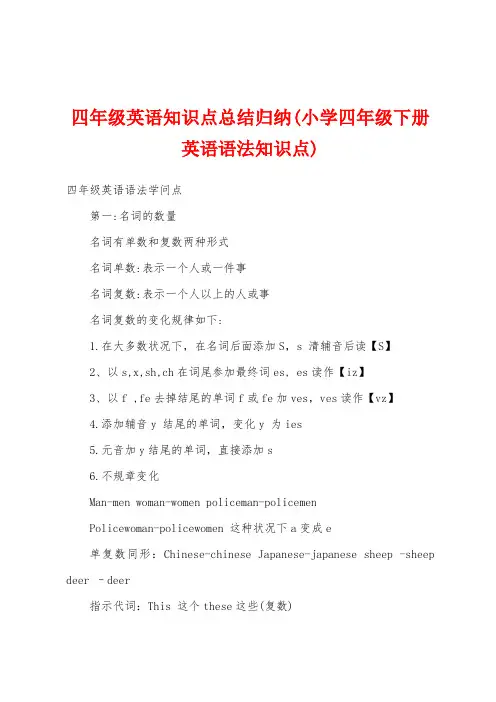
四年级英语知识点总结归纳(小学四年级下册英语语法知识点)四年级英语语法学问点第一:名词的数量名词有单数和复数两种形式名词单数:表示一个人或一件事名词复数:表示一个人以上的人或事名词复数的变化规律如下:1.在大多数状况下,在名词后面添加S,s 清辅音后读【S】2、以s,x,sh,ch在词尾参加最终词es, es读作【iz】3、以f ,fe去掉结尾的单词f或fe加ves,ves读作【vz】4.添加辅音y 结尾的单词,变化y 为ies5.元音加y结尾的单词,直接添加s6.不规章变化Man-men woman-women policeman-policemenPolicewoman-policewomen 这种状况下a变成e单复数同形:Chinese-chinese Japanese-japanese sheep -sheep deer –deer指示代词:This 这个these这些(复数)that那个 those那些(复数)人称代词:第一人称I我 we我们(复数)其次人称:you你you你(复数)he他 she她 it它 they他,他们(复数)am ,is是 are(复数)其次:人称代词分为主格和宾格。
主格和宾格的区分:主格和宾格汉语意思一样,但位置不同。
I(主格)“我“-- me (宾格)“我“主格通常放在陈述句中的句首,宾格通常放在动词或介词之后,也就是说宾格不放在句首。
I have a new car.( I 主格)Excuse me (me 宾格)I ask him to go (him 宾格)They sit in front of me (me 宾格)主格(8):I 我you你 he他 she她 it它 we 我们you 你们they 他们(她,他们)宾格(8):me我 you你 him 他her她 it它 us我们 you你们 them 他(她,它) 们第三:名词全部格1.变法:在人名后面添加”s记住:”s要译成“的“ Lucy(全部名词格)Lucy”s2.假如是两个或两个以上人的名词,全部的格子都应当加到最终一个人的名字上”sLily and Lucy (全部名词格)Lily and Lucy”SLily Lucy and Julia (全部名词格) Lily Lucy and Julia”s3、以s结尾的名词复数全部格子都加在后面”,students”第四:动词的用法1.到目前为止,我们学到了什么be动词包括三个单词 am ,is, are 这三个词的汉语意思一样,都是“是“意思,但是这三个字怎么用好呢??请记住以下口决:我是 am 你是 are Is 用于他,她,它2、我是 am eg.:I am a pupil.3、你是 are eg.:You are a girl.4、Is 用于他,她,它 eg.:He is a Chinese boy,She is an English teather,It is acat.看到复数就用are.5、记住:am ,is 的复数是are.6、记住:these 这些 ;those 那些(这两个词都表示复数)小学四年级下册英语语法学问点:一般过去1.一般过去表示过去某个时间发生的动作或存在的状态,往往与表示过去的时间状语相连。
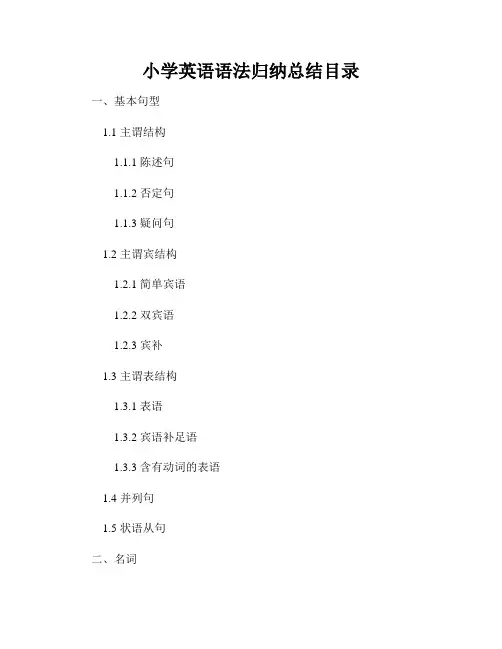
小学英语语法归纳总结目录一、基本句型1.1 主谓结构1.1.1 陈述句1.1.2 否定句1.1.3 疑问句1.2 主谓宾结构1.2.1 简单宾语1.2.2 双宾语1.2.3 宾补1.3 主谓表结构1.3.1 表语1.3.2 宾语补足语1.3.3 含有动词的表语1.4 并列句1.5 状语从句二、名词2.1 可数名词与不可数名词 2.1.1 单数可数名词2.1.2 复数可数名词2.1.3 不可数名词2.2 名词所有格2.2.1 单数名词所有格2.2.2 复数名词所有格2.2.3 不规则名词所有格 2.3 特殊名词2.3.1 复合名词2.3.2 集体名词2.3.3 专有名词三、代词3.1 人称代词3.1.1 主格形式3.1.2 宾格形式3.1.3 形容词性物主代词3.1.4 名词性物主代词3.2 反身代词3.3 指示代词3.3.1 人称指示代词3.3.2 物品指示代词3.3.3 时间指示代词3.4 疑问代词3.4.1 主格疑问代词3.4.2 宾格疑问代词3.4.3 形容词性疑问代词3.4.4 名词性疑问代词四、动词4.1 一般现在时4.1.1 肯定句4.1.2 否定句4.1.3 疑问句4.1.4 特殊疑问词的一般现在时4.1.5 现在进行时4.2 一般过去时……五、形容词与副词5.1 形容词的基本用法5.1.1 修饰名词5.1.2 修饰代词5.2 形容词的比较级和最高级 5.2.1 比较级的基本结构5.2.2 最高级的基本结构5.2.3 不规则比较级和最高级 5.3 副词的基本用法5.3.1 修饰动词5.3.2 修饰形容词和副词5.4 副词的比较级和最高级六、冠词6.1 定冠词6.1.1 特指的事物6.1.2 唯一的事物6.2 不定冠词6.2.1 泛指一个6.2.2 泛指每一个七、介词7.1 英语中常见的介词7.2 常见介词短语7.2.1 在地点上7.2.2 在时间上7.2.3 在关系上八、连词8.1 并列连词8.1.1 连接两个并列的词语 8.1.2 连接两个并列的句子 8.2 从属连词8.2.1 时间从属连词8.2.2 原因从属连词8.2.3 条件从属连词8.2.4 目的从属连词九、感叹句9.1 后置感叹句9.2 前置感叹句十、简单句和复合句的转换10.1 从简单句到复合句10.2 从复合句到简单句这些是小学英语语法的归纳总结目录,希望对你有帮助。
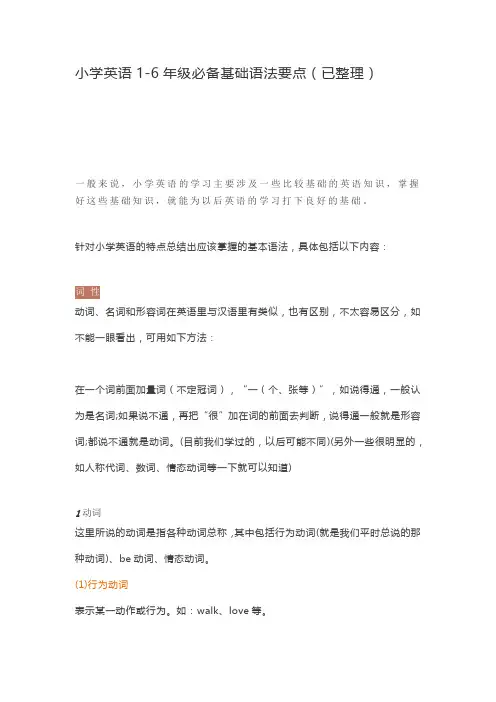
小学英语1-6年级必备基础语法要点(已整理)一般来说,小学英语的学习主要涉及一些比较基础的英语知识,掌握好这些基础知识,就能为以后英语的学习打下良好的基础。
针对小学英语的特点总结出应该掌握的基本语法,具体包括以下内容:动词、名词和形容词在英语里与汉语里有类似,也有区别,不太容易区分,如不能一眼看出,可用如下方法:在一个词前面加量词(不定冠词),“一(个、张等)”,如说得通,一般认为是名词;如果说不通,再把“很”加在词的前面去判断,说得通一般就是形容词;都说不通就是动词。
(目前我们学过的,以后可能不同)(另外一些很明显的,如人称代词、数词、情态动词等一下就可以知道)1动词这里所说的动词是指各种动词总称,其中包括行为动词(就是我们平时总说的那种动词)、be动词、情态动词。
(1)行为动词表示某一动作或行为。
如:walk、love等。
行为动词我们已学过它们的四种形式:原形、+s/es、+ed、+ing,(2)be动词a、口诀:我用am,你用are,is用在他她它,所有复数全用are。
b、肯定和否定句My hair is(not)long.Her eyes are(not)small.c、一般疑问句Am I a Chinese?Yes,you are.No,you aren’t.Are they American?Yes,they are.No,they aren’t.Is the cat fat?Yes,it is.No,it isn’t.我们现在学过的be动词大致分两类:is、am、are为一类,一般用于一般现在时、现在进行时和一般将来时中,was和were为另一类,一般用于一般过去时。
(3)情态动词情态动词也是一类特殊的动词,平时我们不把它说成是动词。
情态动词可以和行为动词同时出现在同一个句子中。
我们现在学过的情态动词有:can、must、should、would、may。
接触最多的是can。
情态动词后动词总是用原形。
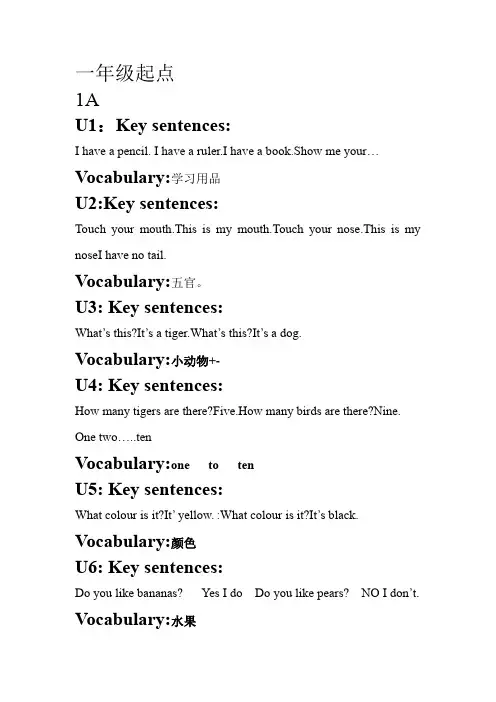
一年级起点1AU1:Key sentences:I have a pencil. I have a ruler.I have a book.Show me your…Vocabulary:学习用品U2:Key sentences:Touch your mouth.This is my mouth.Touch your nose.This is my noseI have no tail.Vocabulary:五官。
U3: Key sentences:What’s this?It’s a tiger.What’s this?It’s a dog. Vocabulary:小动物+-U4: Key sentences:How many tigers are there?Five.How many birds are there?Nine. One two…..tenVocabulary:one to tenU5: Key sentences:What colour is it?It’ yellow.:What colour is it?It’s black. Vocabulary:颜色U6: Key sentences:Do you like bananas? Yes I do Do you like pears? NO I don’t. Vocabulary:水果1BU1:Key sentences:On the desk. Where is the ruler. It’s on the desk.Put your schoolbag under the chair.Vocabulary:blackboard desk chair on under in U2:Key sentences:What’s behind the door. The chairWhat’s under the desk. A bird.Vocabulary:light bed door box near behindU3: Key sentences:Can I Have a card? Sure. Can I have a bear? Sorry,no.I am hungry. I want rice and vegetables Here you are. Vocabulary:食物U5: Key sentences:Do you want tea? Yes, thanks. Yes pleaseI’m thirsty. Do you want water ? No,thanks.I want juice. Vocabulary:饮料U6: Key sentences:I like your skirt./T-shirt.Vocabulary:衣服2AU1:Key sentences:Who’s he? He is my father.Who’s she? She is my mother.Welcome. Nice to meet you. Vocabulary:亲属称呼U2:Key sentences:What’s his name? His name is PanpanWhat’s her name ?Her name is Candy.Boy or girl?Is he a boy?...Vocabulary:周围常见人物称呼U3: Key sentences:What does he look like? He is tall.单三入门Do DoesVocabulary:形容人的词汇deliciousU4: Key sentences:Where are/we you going? I’m going to the zoo/park. We just stay at home.I’m happy at home with my friends.Happy birthday.Vocabulary:生活中常见场所U5: Key sentences:There is a boat on the lake.There are trees/birds in the park. Grammar:There be 句型Vocabulary:公园中常见景物U6: Key sentences:Happy holidaysHere is a present for you. Thank you. Merry Christmas.You /Me tooVocabulary:圣诞相关词汇2BU1:Key sentences:Can you play football/ride a bike/swim? Yes I Can. No, I can’t.Vocabulary:运动游戏U2:Key sentences:What’s the weather like today,Dad?=How’s the weather today?It’s sunny.Wow!Let’s go and play football.What’s the weather like in Shanghai? It’s rainy Vocabulary:天气Grammar:名称变形容词加Y后缀U3:Key sentences:What’s your favourite season?I want to fly a kite.Let’s water the peanuts.Grammar:主宾格Vocabulary:季节感受温度的形容词U4: Key sentences:What time is it?=What’s the time? It’s 7:40Vocabulary:数字十一到二十三十四十五十U5: Key sentences:When do you eat breakfast/get up every day? At 7:10. It’s time to go.Vocabulary:常见一日生活活动短语U6: Key sentences:My weekWhat day is it today?(星期)It’s Sunday.What date is it today?(日期)Vocabulary:星期Grammar:单三3AU1:特殊疑问句,U2: 动词第三人称单数what’sthe matter?=what’s wrong with you?U3:吃早饭;可数名词单复数U4:单三复数U5:情态动词should一般将来时U6:月份表达,具体日期表达,Jan.---December3BU1:school subjects 学校科目U2:school学校U3:一般将来时,be going to do sth.U4:一般疑问句和亲属称呼U5:现在进行时U6:Where is your aunt?和What’s she doing?的特殊疑问句4AU1:often 频率副词一般疑问句,陈述句U2:often 频率副词特殊疑问句。

小学英语语法总结全集 Modified by JACK on the afternoon of December 26, 2020小学英语语法总结全集四大时态一、一般现在时?一般现在时的功能:1.表示事物或人物的特征、状态。
例:The sky is blue.2.表示经常性或习惯性的动作。
如:I get up at six every day.我每天六点起床。
3.表示客观现实。
如:The earth goes around the sun.地球绕着太阳转。
(句中一般含有usually , often , always , sometimes , every week等)一般现在时的构成:肯定句1. be动词:主语+be(am, is, are)+其它。
如:I am a boy.我是一个男孩。
(我用am,你用are,is 连着he she it , 单数is,复数are )2.行为动词:主语+行为动词(+其它)。
如:We study English.我们学习英语。
(当主语为第三人称单数(he, she,it)时,要在动词要变成V3单。
V3单的变化规则1.一般情况下,直接加-s,如:cook-cooks, milk-milks2.以s. x. sh. ch. o结尾,加-es,如:guess-guesses, wash-washes, watch-watches go-goes3.以“辅音字母+y”结尾,变y为i, 再加-es,如:study-studies一般过去时? 否定句:be+not ; V助+not一般疑问句:Be / V助提前(some改为any, and改为or,第一二人称互换)二、现在进行时/正在进行时一般现在时的功能:表示现在正在进行或发生的动作,也可表示当前一段时间内的活动或现阶段正在进行的动作。
(句中一般含有now, look, listen.)现在进行时的构成:肯定句主语+ be +V-ing.动词加ing的变化规则1.一般情况下,直接加ing,如:cook-cooking2.以不发音的e结尾,去e加ing,如:make-making, taste-tasting3.如果末尾是辅音+元音+辅音字母,双写末尾的辅音,再加ing,如:run-running, stop-stopping swimming (listen除外,直接加ing)否定句:be+not一般疑问句:be提前(some改为any, and改为or,第一二人称互换)三、一般将来时概念:表示将要发生的动作或存在的状态及打算、计划或准备做某事。
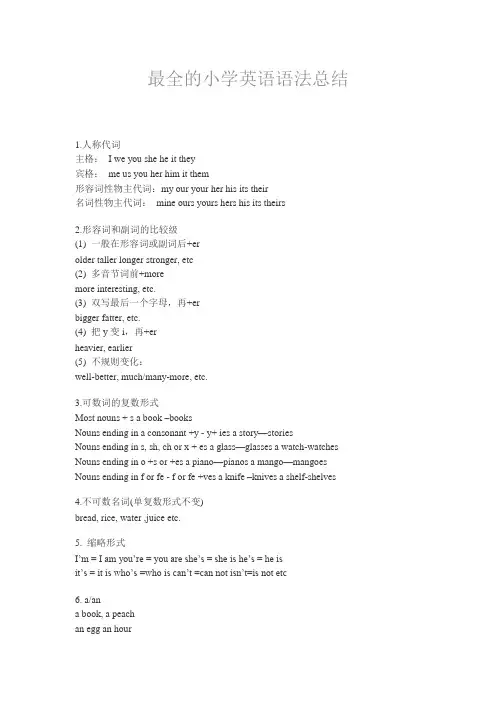
最全的小学英语语法总结1.人称代词主格:I we you she he it they宾格:me us you her him it them形容词性物主代词:my our your her his its their名词性物主代词:mine ours yours hers his its theirs2.形容词和副词的比较级(1) 一般在形容词或副词后+erolder taller longer stronger, etc(2) 多音节词前+moremore interesting, etc.(3) 双写最后一个字母,再+erbigger fatter, etc.(4) 把y变i,再+erheavier, earlier(5) 不规则变化:well-better, much/many-more, etc.3.可数词的复数形式Most nouns + s a book –booksNouns ending in a consonant +y - y+ ies a story—storiesNouns ending in s, sh, ch or x + es a glass—glasses a watch-watches Nouns ending in o +s or +es a piano—pianos a mango—mangoes Nouns ending in f or fe - f or fe +ves a knife –knives a shelf-shelves4.不可数名词(单复数形式不变)bread, rice, water ,juice etc.5. 缩略形式I’m = I am you’re = you are she’s = she is he’s = he isit’s = it is who’s =who is can’t =can not isn’t=is not etc6. a/ana book, a peachan egg an hour7. Preposition:on, in ,in front of, between, next to, near, beside, at, behind.表示时间:at six o’clock, at Christmas, at breakfaston Monday on 15th July On National Dayin the evening in December in winter8. 基数词和序数词one – first two-second twenty-twentieth9. Some /anyI have some toys in my bedroom.Do you have any brothers or sisters?10. be 动词(1) Basic form: am/are/is(2) 肯定和否定句I am(not) from London.My eyes are(not) small.My hair is(not) long.(3)一般疑问句:Am I a Chniese? Yes, you are. No, you aren’t. Are they American? Yes, they are. No, they aren’t.Is the cat fat? Yes, it is. No, it isn’t.11. there be 结构肯定句:There is a …There are …一般疑问句:Is there …? Yes, there is./ No, there isn’t.Are there…? Yes, there are. /No, there aren’t.否定句:There isn’t …. There aren’t….12. 祈使句Sit down pleaseDon’t sit down, please.13. 现在进行时.通常用―now‖.形式:be + verb +ingeg: I am(not) doing my homework.You/We/They are(not) reading.He/She/It is(not) eating.动词—ing 的形式Most verbs +ing walk—walkingVerbs ending in e -e + ing come—comingShort verbs ending in a vowel + a consonant run –running swim—swimming14 一般现在时。
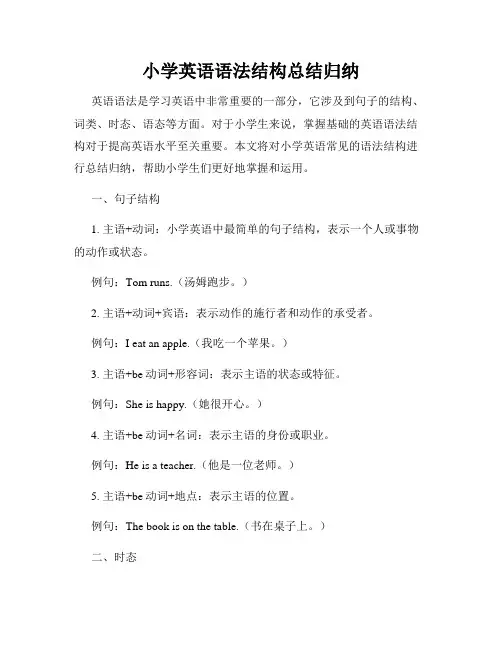
小学英语语法结构总结归纳英语语法是学习英语中非常重要的一部分,它涉及到句子的结构、词类、时态、语态等方面。
对于小学生来说,掌握基础的英语语法结构对于提高英语水平至关重要。
本文将对小学英语常见的语法结构进行总结归纳,帮助小学生们更好地掌握和运用。
一、句子结构1. 主语+动词:小学英语中最简单的句子结构,表示一个人或事物的动作或状态。
例句:Tom runs.(汤姆跑步。
)2. 主语+动词+宾语:表示动作的施行者和动作的承受者。
例句:I eat an apple.(我吃一个苹果。
)3. 主语+be动词+形容词:表示主语的状态或特征。
例句:She is happy.(她很开心。
)4. 主语+be动词+名词:表示主语的身份或职业。
例句:He is a teacher.(他是一位老师。
)5. 主语+be动词+地点:表示主语的位置。
例句:The book is on the table.(书在桌子上。
)二、时态1. 一般现在时:表示当前的状态或经常性的动作。
例句:I play basketball every day.(我每天打篮球。
)2. 一般过去时:表示过去发生的动作或存在的状态。
例句:She watched a movie last night.(她昨晚看了一部电影。
)3. 一般将来时:表示将来发生的动作或存在的状态。
例句:We will go shopping tomorrow.(我们明天去购物。
)4. 现在进行时:表示现在正在进行的动作。
例句:They are playing soccer in the park.(他们正在公园里踢足球。
)5. 过去进行时:表示过去某个时间正在进行的动作。
例句:He was reading a book at that time.(那时候他正在读书。
)三、词类1. 名词:表示人、事物、地点等。
例句:The cat is sleeping.(猫正在睡觉。
)2. 动词:表示动作或状态的词。
(完整版)小学英语语法总结全集小学英语语法总结全集小学英语语法汇总(一)可数名词与别可数名词“分家”一、可数名词与别可数名词的区不一般名词所表示的人或事物是能够按个数计算的,这类名词叫可数名词。
可数名词分为个体名词(表示某类人或事物中的个体,如worker, farmer, desk, fact ory等)和集体名词(表示作为一具整体来看的一群人或一些事物,如people,fa mily 等)。
假如一般名词所表示的事物是别能按个数来计算的,这类名词就叫别可数名词。
别可数名词分为物质名词(表示无法分为个体的物质,如meat, rice, water, milk, orange 等)和抽象名词(表示动作、状态、事情、品质等抽象概念,如work, homework, time, health, friendship等)。
二、可数名词的家务事可数名词有单数和复数两种形式。
指一具人或一件事物时,用单数形式;指两个或多个人或事物时用复数形式。
名词由单数形式变成复数形式的规则如下: 1. 普通的名词词尾直截了当加-s 。
如:book → books room → roomshouse → houses day → days2. 以s,ss, ch,sh, x 结尾的名词,在词尾加-es 。
如:bus → buses glass → glasseswatch → watchesdish → dishes box → boxes3. 以"辅音字母+y"结尾的名词,要先将y改为i再加-es。
如:city → cities body → bodiesfactory → factories等等。
4. 以f 或fe 结尾的名词,要将f或fe改为v再加-es。
如:half → halves leaf → leavesknife → knives wife → wives5. 特例[悄悄话:特例常常考,要记住。
外研版英语六年级上册语法知识点总结(精编)外研版六年级英语语法知识点包括以下内容:1. 一般现在时:以动词原形作谓语,表示经常性、习惯性或普遍性的动作或状态。
2. 一般过去时:动词过去式作谓语,表示过去发生的动作或状态。
3. 现在进行时:be + 动词-ing形式,表示当前正在进行的动作。
4. 祈使句:用于发出命令、请求或建议。
5. 一般将来时:will + 动词原形,表示将要发生的动作。
6. 情态动词:can, could, must, may等,用于表示能力、许可、必须等概念。
7. 名词所有格:表示所属关系的形式,一般在名词后加’s或’来表示。
8. 代词:包括人称代词(I, you, he, she, it, we, they)和物主代词(mine, yours, his, hers, ours, theirs)等。
9. 形容词和副词的比较级和最高级:用于表示两者之间的程度或三者以上的比较。
10. 数词:表示数量和顺序的词,包括基数词(one, two, three)和序数词(first, second, third)等。
11. 不定代词:表示泛指概念的词,包括some, any, no, every 等。
12. 疑问词:用于提问的词,包括what, where, when, who, why等。
13. 定义性从句:用来对前面提到的名词或代词进行解释、说明的从句。
14. 时间状语从句:用于修饰主句,表示时间关系的从句。
15. 原因状语从句:用于修饰主句,表示原因关系的从句。
16. 结果状语从句:用于修饰主句,表示结果关系的从句。
17. 目的状语从句:用于修饰主句,表示目的关系的从句。
18. 条件状语从句:用于修饰主句,表示条件关系的从句。
【导语】海阔凭你跃,天⾼任你飞。
愿你信⼼满满,尽展聪明才智;妙笔⽣花,谱下锦绣⽂章。
学习的敌⼈是⾃⼰的知⾜,要使⾃⼰学⼀点东西,必需从不⾃满开始。
以下是为⼤家整理的《⼩学英语(1-6年级)语法总结及练习题》供您查阅。
⼩学英语语法总结及练习⼀、名词复数规则1.⼀般情况下,直接加-s,如:book-books, bag-bags, cat-cats, bed-beds2.以s. x. sh. ch结尾,加-es,如:bus-buses, box-boxes, brush-brushes, watch-watches3.以“辅⾳字母 y”结尾,变y为i, 再加-es,如:family-families, strawberry-strawberries4.以“f或fe”结尾,变f或fe为v, 再加-es,如:knife-knives,leaf——leaves5.不规则名词复数:man-men, woman-women, policeman-policemen, policewoman-policewomen,child-children, foot-feet, tooth-teethfish-fish, deer-deer, sheep-sheep, people-people, Chinese-Chinese, Japanese-Japanese写出下列各词的复数I _________ him _________ this ___________ her ______watch _______ child _______ photo ________ diary ______day________ foot________ book_______ dress ________tooth_______ sheep ______ box_______ strawberry _____peach______ sandwich ______ dish_______ bus_______man______ woman_______⼆、⼀般现在时⼀般现在时基本⽤法介绍:【No. 1】⼀般现在时的功能1.表⽰事物或⼈物的特征、状态。
【导语】英语语法是针对英语语⾔进⾏研究后,英语语法系统地总结归纳出来的⼀系列语⾔规则。
英语语法的精髓在于掌握语⾔的使⽤。
⼩学阶段的英语学习离不开语法知识,整理了⼩学三年级阶段英语语法知识总结(带练习及答案),在期末来临之际,希望对于教师的语法教学有所帮助! ⼀般疑问句及特殊疑问句 句⼦基本是:简单陈述句,由简单陈述句转变成肯定句,否定句,疑问句。
疑问句是⽤来提出问题。
英语中有四种疑问句: ⼀般疑问句、特殊疑问句、选择疑问句和反意疑问句。
我们现在已经接触到了前两种疑问句。
后两种疑问句以后我们还会学到. ⼀般疑问句: 英语中要⽤ yes和no 来回答的疑问句叫⼀般疑问句。
如: 1)Is it hot ? Yes, it is .\No, it isn't. -- be动词引导 2)Is it a car ? Yes, it is .\No, it isn't . -- be动词引导 3)Is this your ruler ? Yes, it is .\No, it isn't . -- be动词引导 4)Do you like bananas ? -- 含实义动词 Yes, I like bananas. \ No, I don't like bananas. 5)Can Ming hear a drill ? --含情态动词 Yes , Ming can hear a drill.\No,Ming can't hear a drill. 陈述句(肯定句,否定句,⼀般疑问句)的转变规律: 1.肯定句: 2.否定句: 3. ⼀般疑问句及肯否定回答 1) 主语+be动词+…. 1) 主语+be动词+not+…. 1)be动词+主语+…? Yes, 主语+be动词./ No, 主语+be动词+not. I am a teacher. I am not a teacher. Are you a teacher? --Yes, I am./ No, I am not. My mother is thin. My mother is not /isn't thin. Is your mother thin? --Yes, she is./ No, she isn't. They are insects. They are not/aren't insects. Are they insects? --Yes. they are./ No, they aren't. 2) 主语+情态动词can+… 2) 主语+情态动词can+ not+…. 2)情态动词can+主语+…? Yes, 主语+情态动词can/ No,主语+情态动词can+ not He can jump. He can not/can't jump. Can he jump? --Yes,he can./ No, he can't. 3) 主语+动词+…. 3) 主语+助动词do/does+not 3)助动词do/does+主语 +…. 动词原形 +….动词原形? Yes, 主语+助动词do/does. No, 主语+助动词do/does+not. He likes to eat apples. He doesn't like to eat apples. Does he like to eat apples? Yes,he does./ No,he doesn't. We like to eat apples. We don't like to eat apples. Do you like to eat apples? Yes,we do. /No,we don't. ⼆. 祈使句:表⽰请求、命令、建议或劝告等的句⼦叫祈使句,主语you常省略。
1:“first”是序数词,与“the”相连,解释为第一。
2:像“first,term,world”作为词组出现时前面要加“the”。
3:“all”所有;后面的可数名词用复数形式,be动词用“are”。
4:“any”一些;用在否定句和一般疑问句中,与“some”同义。
“some”用在肯定句中。
5:there be+数词,采用“就近原则”。
6:a map of China 与 a map of the world 要牢记。
7:要用“on the wall”,不能用“in the wall”。
门、窗在墙上才能用“in the wall”。
8:can 后+动词原形。
9:play+the+乐器; play+球类;10:like的用法11:动词变动名词形式方法:A--直接在动词后面+ing形式(大多数)。
B--以不发音的“e”结尾的,要去掉e后再+ing,比如:dancing,making,riding。
C--重读be音节,末尾只有一个辅音,须双写末尾的字母后再+ing,如:running,swimmi ng,sitting,putting。
12:现在进行时的构成:be动词+动词ing形式。
标志:now、look、listen、its time to。
13:现在进行时的一般疑问句 /问--be动词+人称+时态(动词ing)答--Yes,he/She/it is/am/are. No,he/She/it isnt/arent/am not.14:用Are you...? Yes,I am/ we are. No,Im not/We arent.15: 动词后+人称宾格形式.16:一般现在时的构成:第三人称单数(三单)。
要注意:后面的动词+s或es。
特例:have→has do→dose go→goes; 标志:often,usually。
17:有些名词变动词时要变形式,例如:teacher→teach;driver→drive.1.一般现在时一般现在时态中,动词一般用原形。
一年级起点1AU1:Key sentences:I have a pencil. I have a ruler.I have a book.Show me your…Vocabulary:学习用品U2:Key sentences:Touch your mouth.This is my mouth.Touch your nose.This is my noseI have no tail.Vocabulary:五官。
U3: Key sentences:What’s this?It’s a tiger.What’sthis?It’s a dog. Vocabulary:小动物+-U4: Key sentences:How many tigers are there?Five.How many birds arethere?Nine. One two…..tenVocabulary:one to tenU5: Key sentences:What colour is it?It’ yellow.:Whatcolour is it?It’s black. Vocabulary:颜色U6: Key sentences:Do you like bananas? Yes Ido Do you like pears? NO I don’t. Vocabulary:水果1BU1:Key sentences:On the desk. Where is the ruler. It’s on the desk.Put your schoolbag under the chair.Vocabulary:blackboard desk chair on under in U2:Key sentences:What’s behind the door. The chairWhat’s under the desk.A bird.Vocabulary:light bed door box near behindU3: Key sentences:Can I Have a card? Sure. Can I have a bear? Sorry,no.I am hungry. I want rice and vegetables Here you are. Vocabulary:食物U5: Key sentences:Do you want tea? Yes, thanks. Yes pleaseI’m thirsty. Do you want water ?No,thanks.I want juice. Vocabulary:饮料U6: Key sentences:I like your skirt./T-shirt.Vocabulary:衣服2AU1:Key sentences:Who’s he? He is my father.Who’s she? She is my mother.Welcome. Nice to meet you. Vocabulary:亲属称呼U2:Key sentences:What’s his name? His name is PanpanWhat’s her name ?Her name is Candy.Boy or girl?Is he a boy?...Vocabulary:周围常见人物称呼U3: Key sentences:What does he look like? He is tall.单三入门Do DoesVocabulary:形容人的词汇deliciousU4: Key sentences:Where are/we you going? I’m going to the zoo/park. We just stay at home.I’m happy at home with my friends.Happy birthday.Vocabulary:生活中常见场所U5: Key sentences:There is a boat on the lake.There are trees/birds in the park. Grammar:There be 句型Vocabulary:公园中常见景物U6: Key sentences:Happy holidaysHere is a present for you. Thank you. Merry Christmas.You /Me tooVocabulary:圣诞相关词汇2BU1:Key sentences:Can you play football/ride a bike/swim? Yes I Can. No, I can’t. Vocabulary:运动游戏U2:Key sentences:What’s the weather like today,Dad?=How’s the weather today? It’s sunny.Wow!Let’s go and play football.What’s the weather like in Shanghai? It’s rainy Vocabulary:天气Grammar:名称变形容词加Y后缀U3:Key sentences:What’s your favourite season?I want to fly a kite.Let’s water the peanuts.Grammar:主宾格Vocabulary:季节感受温度的形容词U4: Key sentences:What time is it?=What’s the time? It’s 7:40Vocabulary:数字十一到二十三十四十五十U5: Key sentences:When do you eat breakfast/get up every day? At 7:10. It’s time to go.Vocabulary:常见一日生活活动短语U6: Key sentences:My weekWhat day is it today?(星期)It’s Sunday.What date is it today?(日期)Vocabulary:星期Grammar:单三3AU1:特殊疑问句,U2:动词第三人称单数what’sthe matter?=what’s wrong with you?U3:吃早饭;可数名词单复数U4:单三复数U5:情态动词should一般将来时U6:月份表达,具体日期表达,Jan.---December3BU1:school subjects 学校科目U2:school学校U3:一般将来时,be going to do sth.U4:一般疑问句和亲属称呼U5:现在进行时U6:Where is your aunt?和What’s she doing?的特殊疑问句4AU1:often 频率副词一般疑问句,陈述句U2:often 频率副词特殊疑问句。
陈述句U3:usually频率副词by+交通工具=take+交通工具on foot= walk,简单讲解动名词U4:Can I use your…….?U5:祈使句U6:want的用法want to be. 4B(to be continued待续)上教牛津5AU1:want to beU2:How do you come to school?by交通工具,U3:When’s your birthday?1-30th,日期表达U4:频率副词usually-often-sometimes-always-neverU5:both,and allU6:现在进行时陈述句U7:现在进行时一般疑问句U8:现在进行时特殊疑问句U9:问路,走路的方向U10:现在进行时和形容词-副词,副词修饰动词的用法U11:use的用法以及with的转换U12:情态动词must的用法,肯定与否定5BU1:名词性物主代词U2:Why…?Because 的问与答U3:will的一般将来时陈述句U4:be going to sth.一般将来时的陈述句U5:be going to sth.一般将来时的特殊疑问句U6:will一般将来时的特殊疑问句U7:wil一般将来时U8:which引导的选择疑问句U9:情态动词shouldU10:inventions 发明,think&known引导的宾语从句入门,(看情况讲不讲)U11:综合复习U12:综合复习6AU1:was 的一般过去时U2:一般过去时U3:一般过去时特殊疑问句U4:一般过去时一般疑问句U5:一般过去时的there be 句型U6:Would you like to do sth.?U7:一般将来时shall的一般疑问句U8:一般过去时U9:How long 的用法take 花费时间,东西南北U10:keep的用法U11:get from ; use toU12:stop doing sth.6BU1:How tall are you ?how much do you weigh?U2:一般过去时与一般现在时的转换U3:一般将来时的复习与加深U4: be going to 某地;现在进行时表示将来时U5:make应用U6:PE lessonsU7:一般过去时,一般现在时,现在进行时,情态动词的综合应用U8:情态动词may can must could.U9:综合复习U10:综合复习U11:综合复习U12: 综合复习。